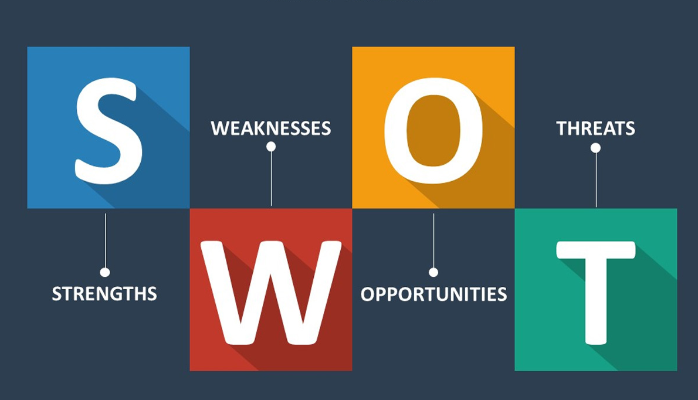How to Identify and Use Your Strengths, Weaknesses, Opportunities and Threats to Your Advantage

Whether you’re starting a new business or operating an existing company, a SWOT Analysis is an incredibly simple, yet powerful tool to help you develop your business strategy. This framework is used to evaluate a company’s competitive position and to develop its strategic plan. SWOT stands for Strengths, Weaknesses, Opportunities and Threats.
Strengths and weaknesses are internal to your company—things that you have some control over and can change. Examples include your team, your company’s branding, unique capabilities and key processes.
Opportunities and threats are external—things that are going on outside or external to your company. You can take advantage of opportunities and protect against threats, but you can’t change them. Examples include competitors, prices of raw materials and interest rates.
You may think that you already know everything that you need to do to succeed, but a SWOT Analysis will force you to look at your business in new ways and from new directions. You’ll look at your strengths and weaknesses, and how you can leverage those to take advantage of the opportunities and threats that exist in your market.
How To Do a SWOT Analysis
To start, gather your team to work on a SWOT Analysis. You don’t need an all-day retreat to get it done…one or two hours should be more than enough. Conducting a SWOT Analysis is similar to a brainstorming session.
Start with Strengths. Give everyone a pad of sticky notes and have them quietly generate ideas on their own to start. This prevents groupthink and ensures that all voices are heard.
After five to ten minutes of private brainstorming, put all the sticky notes up on a flipchart in the Strength quadrant, like the image below, and start grouping similar ideas together. Allow anyone to add additional notes at this point if someone else’s idea sparks a new thought.
Once all of the ideas are organized, it’s time to rank the ideas. You can use a voting system where everyone gets ten “votes” they can distribute in any way they like. Sticky dots in different colors are useful for this portion of the exercise. Based on the voting exercise, you should have a prioritized list of Strengths for your organization. Of course, the list is now up for discussion and debate, and someone in the room should be able to make the final call on the priority.
You’ll want to follow this same process of generating ideas for each of the four quadrants of your SWOT Analysis: Strengths, Weaknesses, Opportunities and Threats.
Here’s what a SWOT Analysis might look like for a custom home builder:

What’s Next
With your SWOT brainstorming and prioritizing complete, you’re ready to convert these into real strategies. After all, the exercise is about identifying and implementing strategies you can work to improve your business.
The first step is to look at your strengths and figure out how you can use those strengths to take advantage of your opportunities. Then, look at how your strengths can combat the threats in your market.
Using the previous home builder SWOT example, the following are potential strategies to work on in the business:
- Improve Product Quality by developing an inspection checklist and process.
- Adopt Technology Tools to automate the estimating and sales processes.
- Capitalize your marketing and branding on Green Building.
The results of your SWOT Analysis will provide a focused list of strategies to help you grow your business and improve your performance.
